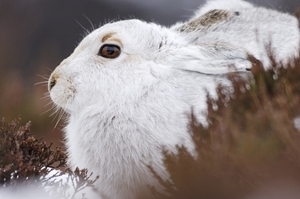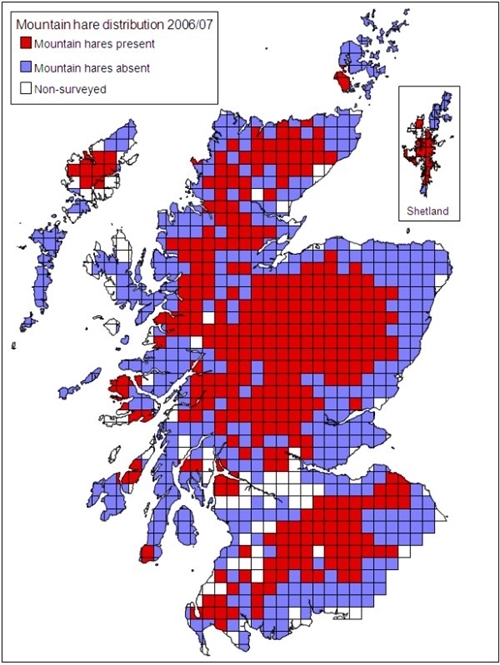For information about or to take part in the current Scottish Mountain Hare Survey, click here.
 Mountain hares are currently listed in Annex V of the EC Habitats Directive (1992), as a species "of community interest whose taking in the wild and exploitation may be subject to management measures".
Mountain hares are currently listed in Annex V of the EC Habitats Directive (1992), as a species "of community interest whose taking in the wild and exploitation may be subject to management measures".
The government is therefore required to ensure that the conservation status of mountain hares within the UK is favourable and that their populations are managed sustainably.
However, as at the time there had been no comprehensive surveys of mountain hare distribution and consequently no reliable estimates of abundance, it was not possible to assess whether the species met the EC Habitats Directive objectives. As a result of these issues and recent suggestions that mountain hares may be in decline, the species was added to the UK Biodiversity Action Plan list in 2007 to promote future research.
In 2007, the Trust (in collaboration with the Macaulay Institute and the Scottish Gamekeepers Association) was commissioned by Scottish Natural Heritage to undertake a postal survey 2007 to assess the current distribution of mountain hares within Scotland and investigate the level of harvest and control of this species. The results of the study were to be compared to findings from a similar study performed by the Trust in 1995/96 (Tapper 1996) to assess whether there have been any changes in the distribution of mountain hares.
Survey forms were mailed to Scottish members of the Trust, the National Gamebag Census and the Scottish Gamekeepers Association, along with many land owning organisations. These forms requested contacts to return information regarding the presence/absence of mountain hares on their land. In addition, the number of mountain hares taken (if any) either through harvesting (let and un-let shooting) or population control (protection of forestry/woodland regeneration or to control tick numbers on grouse moors) was requested.
We received an overwhelming response, with over 900 questionnaires returned. In addition, mountain hare data was submitted by many landowners outwith our membership, along with various organisations and members of the public.
As a result, working in partnership with the Macaulay Institute, we were able to produce a particularly comprehensive report on the distribution of Scotland’s mountain hares as commissioned by Scottish Natural Heritage (Kinrade et al., 2008). This included the first in-depth distribution map for mountain hares across Scotland which can now be used as a benchmark to monitor mountain hare distribution in the future.
This is particularly important as the mountain hare is now a Biodiversity Action Plan (BAP) species, so more attention will be paid to its management and status. It also allowed us to compare the distribution and level of harvest of mountain hares to that of a smaller-scale survey performed in 1995/96 (Tapper, 1996), providing scientists and policy makers with up-to-date information on any recent changes.
The total area surveyed for mountain hares was 71,098 km2, equivalent to 90% of the total area of Scotland. Of this area, mountain hares were present on 34,359 km2 (48%) and absent from 36,739 km2 (52%; see Figure 1 below).
We were particularly interested in how distribution might have changed since the 1995/96 survey. Of the 20,462 km2 area (26% of the total area of Scotland) surveyed in both 2006/07 and 1995/96, mountain hares were consistently seen in 59% of the area and were consistently absent from 21%. Of the remaining area, mountain hares were present in 10% of the area in 1995/96 but not 2006/07 and present in 9% in 2006/07 but not in 1995/96.
This suggests that there has been no net gain or loss in distribution in the area surveyed in both 1995/96 and 2006/07. It should be noted however, that it is not possible to assess whether mountain hare distribution has changed outwith this area. Frustratingly we cannot comment on mountain hare abundance as both studies focused on distribution rather than the number of mountain hares across Scotland.
It is widely accepted that mountain hares are closely associated with grouse moors as the management of heather moorland for red grouse also benefits mountain hares (Hewson, 1984; Hudson, 1992). We therefore compared the intensity of management of the estates surveyed in 2006/07 to the total area of mountain hare presence on those estates.
The estates were divided into three management groups; those that undertake extensive heather management and predator control (driven grouse moors), those that undertake a lesser degree of heather management and predator control (walked-up grouse moors) and those that perform minor (if any) management (no grouse interest). This comparison showed that on average, mountain hares were reported on 64% of the area of driven grouse moors, compared with just 9% of walked-up grouse moors with mountain hares essentially absent from estates which had no grouse interest.
The survey found that 24,529 mountain hares were taken in 2006/07 across 90 estates which represent 7% of the 350,000 mountain hares estimated as the UK population in 1995 (Harris et al., 1995; it is recognised that this population estimate may be either overestimated or underestimated by up to 50% owing to the limited data available for the species and that the majority (99%) is in Scotland). The majority of the mountain hares taken were for the purposes of tick control (50%), followed by sport (40%) and crop/forestry protection (10%).
The main reason for taking mountain hares has changed over the last 11 years as in 1995/96 the majority were taken for sport (60%). The number of mountain hares taken in 2006/07 was 32% more than in 1995/96 over the same area; however, we don’t know the size of the population this harvest was taken from and there was no evidence that this level of harvest had reduced the distribution of mountain hares in this area.
Figure 1: The distribution of mountain hares in 2006/07 in Scotland on a 10x10-km square basis. The use of a 10x10-km square scale resulted in some areas appearing to have mountain hares when in fact they were reported as absent. They are (from north to south) Yell (Shetland), Mainland (Orkney), the Morvern peninsula (adjacent to Mull) and Islay

Further reading
- Patton, V., Ewald, J.A., Smith, A.A., Newey, S.J., Iason, G.R., Thirgood, S.J., & Raynor, R. (2010). Distribution of mountain hares Lepus timidus in Scotland: results from a questionnaire. Mammal Review, 40: 313-326.
- Newey, S.J., Willebrand, T., Haydon, D.T., Dahl, F., Aebischer, N.J., Smith, A.A., & Thirgood, S.J. 2007. Do mountain hare populations cycle? Oikos, 116: 1547-1557.
- Newey, S.J., Dahl, F., Willebrand, T., & Thirgood, S.J. 2007. Unstable dynamics and population limitation in mountain hares. Biological Reviews, 82: 527-549.